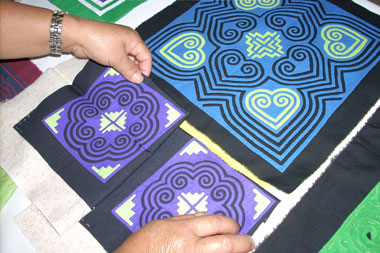Ying Yang
Hmong paj ntaub
 Paj ntaub (pronounced “pan dau,” meaning flowery cloth) are reverse appliquéd and embroidered textiles used for many purposes in traditional Hmong life. Paj ntaub are used as gifts, funeral cloths, baby carriers, decorations, and used to adorn a wide variety of clothing, both ceremonial and secular, including jackets, hats, belts, collars, purses, aprons, and skirts. Paj ntaub became commercialized when Hmong women needed income for family survival in the Thai refugee camps after the end of the Vietnam War.
Paj ntaub (pronounced “pan dau,” meaning flowery cloth) are reverse appliquéd and embroidered textiles used for many purposes in traditional Hmong life. Paj ntaub are used as gifts, funeral cloths, baby carriers, decorations, and used to adorn a wide variety of clothing, both ceremonial and secular, including jackets, hats, belts, collars, purses, aprons, and skirts. Paj ntaub became commercialized when Hmong women needed income for family survival in the Thai refugee camps after the end of the Vietnam War.
Paj ntaub are made by layering fabric cut with designs which is turned under and sewn in tiny stitches by hand to reveal the fabric underneath. Traditional patterns are exact, geometric, symbolic of nature, and combined in multiple creative ways. Design symbols represent nature including mountains, fish scales, seeds, snails, elephant tracks, caterpillar backs, mouse tracks, dragon’s teeth, and hearts. Traditional colors of black, red, white, greet, and yellow have been expanded to all colors available in workable fabrics.
Ying Yang learned to sew from her grandmother and mother in her native Hmong mountain village in the Louang Prabang province in norther Laos. After escaping to a Thai refugee camp in 1975, where she lived for four years with her husband and two children, Ying taught herself how to make paj ntaub from observing other women and practicing.
In 2008, Ying was a master artist in ACTA’s Apprenticeship Program with apprentice Xong Lee. The apprenticeship focused on refining Xong’s skills in designing, folding, and cutting progressively intricate designs in her pieces.
